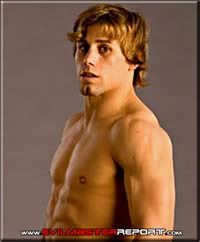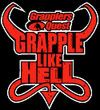WEC Gives The Little Guys There Chance

By Dave Doyle
Until recently, Urijah Faber's career progressed much like many other talented smaller men competing in combat sports.
He was great at what he did. He earned respect from knowledgeable observers for his skills. But he wasn't able to reap the full benefits of his efforts, as larger competitors went on to take the main event spotlight and money.
"It was kind of tough there for awhile," said Faber, who boasts a career record of 17-1. "Mixed martial arts is something you get into because you love it, but of course you want the opportunity to make it big."
But now Faber's getting his time to shine. The Davis, CA, native is the featherweight (145-pound limit) champion of World Extreme Cagefighting, the group that is giving the under-155-pound crowd the spotlight to showcase their skills.
"This is a huge chance for all the smaller fighters out there," said Faber, who defends his title Saturday in Las Vegas. "We've worked just as hard as anyone else and fight just as hard as anyone else. Now that the WEC is focusing on the 135s (bantamweights) and 145s, I think the fans are going to see that our fights are just as exciting to watch as the light heavyweights and the welterweights and everyone else."
For years, a fighter who clocked in below lightweight had little chance of making a splash on the worldwide major-league stage. The Ultimate Fighting Championship abandoned its 155-pound championship for several years, making the 170-pound weight class its lightest title, and the PRIDE Fighting Championships in Japan caps its lightweight division at 163.
UFC restored the 155-lb title last year, which was won by Sean Sherk in a decision over Ken Florian at UFC 64. But that still didn't leave a spot for those under 155, especially considering how fighters the caliber of Sherk dropped down from welterweight to compete at 155.
Into the void stepped UFC owner Zuffa LLC. Looking for a way to expand its reach into the MMA world, the company bought the WEC last November.
The original incarnation of the WEC was a successful minor-league group, which ran shows on Native American reservations in Northern California. Several fighters, like Mike "Quick" Swick and Christian Wellisch, used the WEC as a springboard to the UFC, and the group's shows have featured fighters familiar to fans like Karo Parisyan, Jeremy Horn, Nick Diaz, and Hermes Franca.
"The WEC was already one of the top organizations in the game," said Peter Dropick, a former executive at the Pond in Anaheim who is the WEC's vice-president of operations. "They ran a solid promotion that stayed within their means and produced good fights and good fighters. Our goal is to take the WEC to the next level."
After purchasing the WEC, Zuffa sought to clearly distinguish the group from the UFC brand. In addition to the focus on the featherweights and bantamweights, there is no heavyweight division in the WEC, with the top weight class maxing out at 205. For another, the WEC fighting surface is 25 feet x 25 feet, five feet smaller than the UFC octagon, to encourage the lighter-weight fighters' faster-paced action.
The parent company is placing particular emphasis on the notion that the WEC, which premieres on the Versus Network in June, will not be a feeder system for the UFC. WEC fighters are told to view their spot in the company as a destination in and of itself, not a springboard to the UFC. You won't see WEC fights on a UFC show.
"The WEC will stand on its own," said Dropick. "There are so many groups on TV today that the viewers might wonder why they should watch the WEC instead of other groups. All they have to do is check us out once. Check out the action the lighter weight classes provide. All you have to do is watch Urijah fight once and you'll be hooked."
If so, that will in large part happen because of Faber's crowd-pleasing style. Faber has displayed his dedication to contact sports since he was an amateur: he walked on to the wrestling team at Cal-Davis as a 133-pound freshman and left in 2003 as the school's all-time win leader. Twice, in the process, he qualified for the NCAA Division 1 tournament. Faber holds the school record for most wins in a career (92) and a season (30 in 2003) and is third in school history in win percentage (.662).
Faber also ranks in the top 10 Cal-Davis history for pinfalls, and that tendency for tenacity has carried over to his MMA career. Like any good lighter-weight wrestler, Faber doesn't sit back and wait. "The California Kid" has just two decisions among his 17 victories. Seven times he's won by KO/TKO and seven times he's won on a submission (He also has a disqualification victory). He hasn't been taken to the third round since his only career loss, when he was TKOd by Tyson Griffin in Sept. 2005.
"I just go and go, man," Faber said. "I'm not in there to take my time. I want to take the action right to my opponent and get it on. There are no secrets to what I do out there. Whether I take you out with my standup, or find an opening for a submission, doesn't matter. Whatever comes first.
Saturday, Faber defends his title against Dominic Cruz, who makes his WEC debut. The Tucson native has been fighting professionally for just over two years, but in that time, he's racked up a record of 9-0, tearing his way through the Rage in the Cage and Total Combat promotions.
"He's said he wants to match my standup," said Faber. "Bring it on. Everything I've heard is that he's a strong fighter. I'll fight him standing or on the ground or wherever he wants to go."
The WEC card at the Hard Rock Casino in Vegas features several other matches of note: The vacant WEC welterweight title is on the line when veteran John Alessio takes on Carlos Condit; Eddie Wineland defends his bantamweight (135 lb.) title against Chase Beebe; and Joe "Diesel" Riggs goes up against Miromitsu Mirua in middleweight competition.
(Source)






















No comments:
Post a Comment